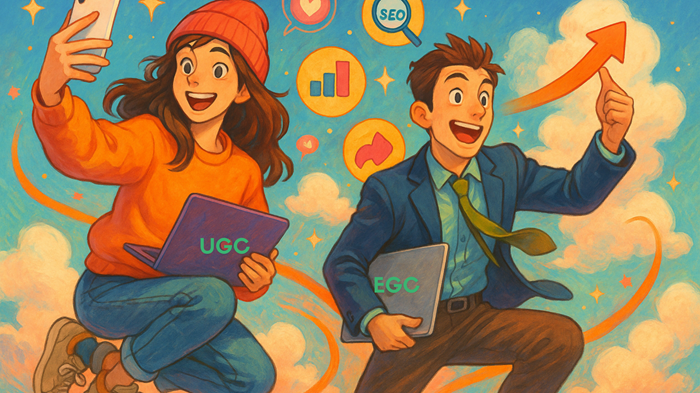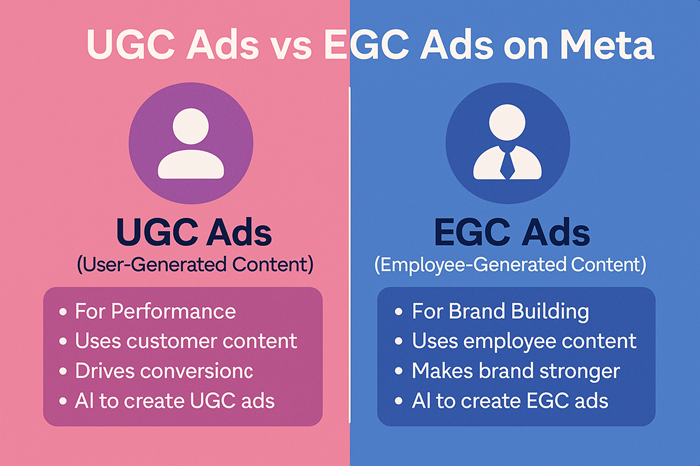In today’s digital-first advertising world, brands are shifting their focus from traditional ad formats to more humanized, authentic, and engaging strategies. Two of the most powerful formats gaining traction on Meta platforms (Facebook, Instagram, WhatsApp) are UGC (User Generated Content) and EGC (Employee Generated Content) ads. While UGC is driving performance marketing with real user testimonials and content, EGC is shaping brand narratives by leveraging internal voices to build trust and authority.

In this detailed guide, we’ll dive deep into:
- The definitions and differences between UGC Ads vs EGC Ads on Meta
- Their individual strengths for performance vs branding
- Best practices for leveraging them on Meta
- How AI can supercharge the creation process
- Real world examples of UGC Ads vs EGC Ads on Meta
- UGC Ads vs EGC Ads on Meta FAQs
- A conclusive roadmap for brands in 2025 and beyond
What is UGC (User Generated Content)?
User Generated Content (UGC) refers to any form of content text, videos, images, reviews created by real users, customers, or fans of a product rather than the brand itself.
Why UGC Works:
- Authenticity: 92% of consumers trust recommendations from peers over branded ads.
- Social Proof: Seeing real people use and recommend your product builds trust.
- Performance Booster: UGC ads often outperform traditional creative due to higher relatability and lower production costs.
UGC on Meta:
- Instagram Reels featuring user testimonials
- Facebook video reviews from real customers
- Carousel ads showcasing before after results from community members
- WhatsApp broadcast campaigns with authentic user reviews
What is EGC (Employee Generated Content)?
Employee Generated Content (EGC) refers to brand related content created and shared by employees. It could be behind the scenes videos, culture posts, product explainers, thought leadership, or day in the life reels.
Why EGC Matters:
- Brand Building: EGC humanizes the brand and builds trust.
- Internal Advocacy: Employees become the brand’s most authentic ambassadors.
- Content Diversity: Employees add fresh perspectives, voices, and creativity.
EGC on Meta:
- Instagram Stories of workplace culture
- Facebook Lives from product teams
- Thought leadership carousels or reels from key employees
- Day in the life shorts on Meta Reels
UGC Ads vs EGC Ads on Meta: Key Differences
| Criteria | UGC (User Generated Content) | EGC (Employee Generated Content) |
|---|---|---|
| Creator | Customers, users, influencers | Employees (across all functions) |
| Goal | Performance marketing, lead generation | Branding, trust building |
| Tone | Relatable, user first | Professional, insightful, behind the scenes |
| Platforms | Instagram, Facebook, WhatsApp, Threads | Same, with added focus on LinkedIn cross promotion |
| Format Types | Reels, reviews, unboxings | Interviews, behind the scenes, explainers |
| Best Use Case | Conversion, retargeting ads | Awareness, retention, storytelling |
Performance Marketing with UGC on Meta
When it comes to driving clicks, sales, or leads, UGC ads are unmatched.
Benefits of UGC in Performance Campaigns:
- Higher CTRs: Real users draw attention.
- Cost-effective: No need for expensive production.
- Scalability: Use AI to scale creative volume fast.
- Trust Factor: New prospects feel safer buying from a peer-recommended brand.
Winning UGC Ad Formats on Meta:
- Dynamic Reels Ads: Show 3–4 quick user testimonials stitched together
- Testimonial Carousels: Feature customer quotes + product visuals
- Before-After Video Ads: Especially effective for skincare, fitness, fashion
Pro Tips:
- Use subtitles on all UGC videos
- Add a clear CTA like “Shop Now” or “See How It Works”
- Pin positive comments on promoted UGC posts
Brand Building with EGC on Meta
For long-term brand growth, trust, and reputation building, EGC is essential.
Why EGC Strengthens Brands:
- Showcases values and transparency
- Builds community and internal pride
- Provides a human face to your company
Types of EGC Content That Work:
- Culture Videos: Office tours, team celebrations
- Expert Takes: Employees breaking down industry trends
- Product Walkthroughs: From the people who built it
- Leadership Reels: Founders or managers sharing philosophies
Platforms to Use:
- Instagram: For culture + visuals
- Facebook: For longer form or community discussion
- LinkedIn (cross-shared): For professional credibility
Tips for Great EGC Ads:
- Keep it authentic and unscripted
- Train internal teams for mobile first video shooting
- Repurpose internal events or meetings into short form reels
How to Use UGC Ads vs EGC Ads on Meta Together for Best Results
Smart brands are blending both formats for a full-funnel strategy.
Funnel Breakdown:
- TOFU (Top of Funnel) – Brand Awareness
- Use EGC reels: Founder messages, behind-the-scenes, employee voices
- Goal: Build trust and familiarity
- MOFU (Middle of Funnel) – Consideration
- Use UGC testimonials + influencer videos
- Goal: Build confidence in product efficacy
- BOFU (Bottom of Funnel) – Conversion
- Retargeting using UGC before-after or demo videos
- Goal: Nudge to final decision
Leveraging AI to Create UGC and EGC Ads
AI tools are revolutionizing how brands scale their ad content with speed and personalization.
AI for UGC:
- Script Generation: Tools like Jasper or ChatGPT can write UGC scripts for influencers.
- Voice Cloning: Tools like Descript for generating voiceovers if you lack audio.
- Video Editing: Use Pictory or InVideo to convert testimonials into polished videos.
- Synthetic UGC Creators: Deepfake-based tools can generate avatars that simulate real users (use with caution and disclosure).
AI for EGC:
- Presentation Tools: Beautiful.ai, Canva, or Tome to create employee slide-style content.
- Interview Transcription: Otter.ai or Fireflies can convert team discussions into text for repurposing.
- Text to Video: Synthesia or HeyGen to turn text explainers into branded employee-like videos.
- Voice-to-Reel Conversion: Convert audio clips from employee meetings into engaging short videos with subtitles and stock visuals.
Meta Ad Tools That Support UGC & EGC
- Meta Ads Manager: For managing all UGC and EGC campaigns with audience segmentation
- Advantage+ Creative: Automatically enhances UGC visuals or EGC creatives
- Branded Content Ads: Promote influencer content with performance tracking
- Meta Creator Studio: Schedule and manage employee-led campaigns
- Collaborative Ads: Ideal for brand-influencer partnerships using UGC
Best Practices for Brands in 2025
- Create UGC Brief Kits: Share a clear style guide with real customers or micro-influencers.
- Incentivize Employees: Offer bonuses or rewards for generating EGC content.
- Tag Everything Smartly: Use custom hashtags to classify content types (#MyBrandStory, #RealUserExperience)
- A/B Test: Constantly test UGC vs EGC ads with different hooks.
- Use Retargeting Smartly: Retarget with stronger UGC once awareness is built via EGC.
Case Studies
Brand A: Skincare D2C
- Used customer UGC Reels for retargeting
- EGC videos featuring product developers for education
- 40% uplift in conversion rate with combined format
Brand B: SaaS Company
- Created weekly “Tech Talk” videos from developers (EGC)
- Added user testimonials into webinar ads (UGC)
- Saw 35% drop in CPL on Meta in 2 months
UGC Ads vs EGC Ads on Meta : FAQs
Q1. Are UGC ads more cost-effective than branded content?
Yes. UGC can be sourced from real users or low-cost creators, reducing shoot and edit expenses.
Q2. How to get users to send UGC?
Offer loyalty points, contests, or discount codes for sharing product reviews, testimonials, or unboxing videos.
Q3. Is EGC suitable for B2C brands?
Absolutely. EGC works especially well for D2C and retail brands showing operations, production, or customer support insights.
Q4. Can AI replace human-created UGC or EGC?
AI can support and scale content but should not completely replace authentic human voices. Use it for augmentation, not imitation.
Q5. Can I run both ad formats in a single campaign?
Yes, using ad sets and placements targeting different stages of the funnel, you can run both formats side-by-side.
Q6. How do I ensure legal compliance with UGC?
Always obtain user permission before promoting their content. Use consent forms and clear guidelines.
Q7: What’s the main difference between UGC and EGC ads on Meta?
A: UGC ads use content from real customers to drive performance and conversions, while EGC ads leverage employee stories to build brand strength and trust.
Q8: Can I use AI to create UGC or EGC ads?
A: Yes! AI can generate realistic UGC-style ads using avatars and scripts, and assist employees in creating and editing EGC content.
Q9: Which Meta ad formats work best for UGC and EGC?
A: Video ads, carousel ads, and stories are highly effective for both UGC and EGC. Single image ads work well for testimonials and spotlights.
Q10: How do I get customers or employees to create content for ads?
A: For UGC, monitor social tags and run challenges. For EGC, encourage employees to share their stories and provide easy tools or prompts.
Q11: How do I measure the success of UGC and EGC ads?
A: For UGC, track performance metrics like ROAS, CPA, and conversions. For EGC, focus on brand lift, recall, and engagement.
UGC Ads vs EGC Ads on Meta Conclusion: A Future-Proof Strategy for Meta Ads
UGC and EGC ads are redefining what it means to connect with audiences on Meta. UGC ads are your go-to for driving sales and conversions with relatable, trustworthy content. EGC ads, meanwhile, are the secret weapon for building a brand that people believe in and want to support.
The integration of AI has made it easier than ever to scale both formats, test new ideas, and optimize for the best results. By combining the immediacy of UGC with the credibility of EGC—and harnessing the power of Meta’s advanced ad formats and AI—you can create a holistic strategy that delivers both short-term wins and long-term brand growth.
Whether you’re a performance marketer or a brand builder, the future of Meta advertising is authentic, data-driven, and powered by both people and technology. Start blending UGC and EGC in your campaigns today, and watch your results soar.
Read more details about UGC vs EGC for Meta
Get regular Digital Marketing Latest Trends & Updates on Popnewsblend.

Hi, I’m Prashant Jain — a curious soul, storyteller, and content creator at heart.I’ve always been drawn to the world of entertainment, travel, sports, health & lifestyle — not just as a writer, but as someone who genuinely lives these experiences. Whether I’m binge-watching the latest OTT series, exploring offbeat spiritual destinations in India, or diving deep into wellness routines and cricket match insights, I love sharing what I discover with like-minded readers.
PopNewsBlend is my way of blending personal journeys with meaningful stories — ones that inform, inspire, and keep you ahead of the curve. Everything I write comes from real observations, hands-on experiences, and a deep passion for understanding the world around us.
Discover more from Popnewsblend
Subscribe to get the latest posts sent to your email.








Pingback: How Short Video Trends Have Transformed Consumer Behaviour in 2025
Pingback: Festive Season Marketing for D2C Brands: Why Early Planning Cuts CAC & Builds Trust